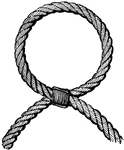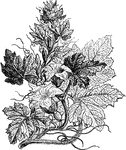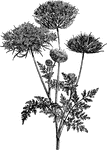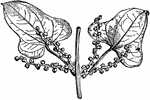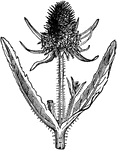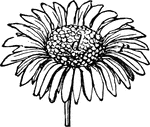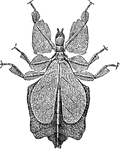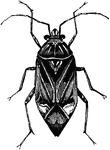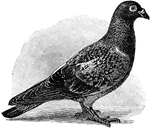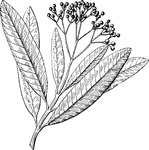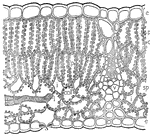
Epidermis
This illustration shows a stem of a plant. e; epidermis; s, stoma; p, palisade mesophyll; ch, chloroplast;…
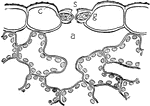
Stoma
This illustration shows a section across a stoma. The stoma is the tiny opening or pore, found mostly…

Aralia
A genus of the plant family Araliaceae, consisting of about 30 species of deciduous and evergreen trees…
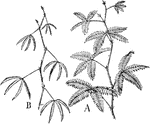
Mimosa
Figure A shows the leaf position of the light sensitive plant, Mimosa in sunlight. Figure B shows it…
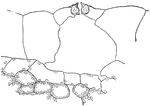
Tradescantia
This illustration shows a close up of the plant tradescantia. It shows the delicate character of the…
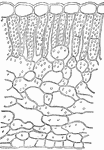
Spathyema
This illustration shows a section of the leaf of skunk cabbage, Spathyema. Note the poorly developed…

Chlamydomonas
This illustration shows the features in the life history of Chlamydomonas: A, character of the motile…
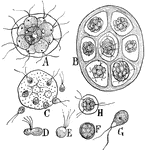
Pandorina
This illustration shows the features in the life history of Pandorina: A, a colony of plants. B, each…
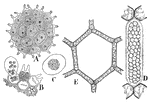
Green Algae
This illustration shows the colonial forms of unicellular green algae: A, Pediastrum, the plants of…
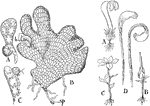
Sphagnum
This illustration shows the germination of the spore Sphagnum: A, early growth of the spore. B, later…
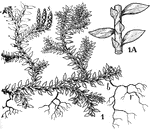
Selaginella
This illustration shows a common cultivated Selaginella: I, habit of the plant-s, strobili; b, a branch…

Lepidium
This illustration shows stages in the germination of the gametospore of Lepidium, sectional view: A,…
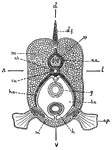
Fish
This is a diagram of the cross section of a fish, showing the bilateral symmetry of the parts: dv, dorsoventral…

Mammillaria
The genus Mammillaria is one of the largest in the cactus family Cactaceae. the distinctive feature…

Redtop
This illustration shows a portion of switchgrass. It is a warm-season plant and it is one of the dominany…

Indian Millet
This is an illustration of the Indian Millet plant. It is native to Nevada and Utah in the southwestern…
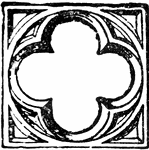
Quatrefoil
In architecture, a piercing or panel divided by cusps or foliations into four leaves, or more correctly…

Horse
A horse, with names of parts. 1, crest; 2, withers; 3, croup; 4, hamstring; 5, hock; 6, cannon; 7, fetlock;…
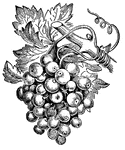
Vine
A well-known climbing shrub, which consists of climbing plants with woody stems, simple or compound…
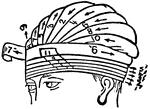
Recurrent Bandage
Applied to various parts. To adjust it to the head make several turns around the head, then pass the…

Spiral Bandage
Applied to parts which do not vary in circumference. It is applied like the oblique except that the…
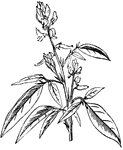
Telegraph Plant
A complicated plant with trifoliate leaves, small flowers, and flat, deeply lobed and jointed pods.
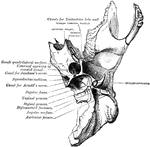
Temporal Bone
Bones situated at the sides and base of the skull. Each consists of five parts: the squama, the petrous,…
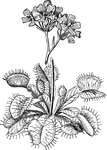
Venus Fly Trap
A plant with a rosette of root leaves, from which rises a naked scape bearing a corymb of rather large…

Protoplasm
The circulation of protoplasm (p) in a cell of the stamen-hair of Tradescania. In the channels the granules…
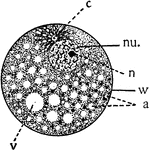
Cell
Diagram showing the principal parts of the cell and something of the protoplasmic architecture as it…

Nervous System
"Scheme showing the essential relations of the parts of a nervous system: 1, the sensory end organ (epithelial);…
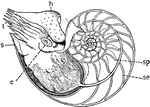
Pearly Nautilus
"Pearly Nautilus. e, eye; h, hood, a muscular portion of the foot which protects the softer parts; s,…
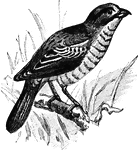
Plant Cutter
A bird that does much damage by cutting tender sprouts and buds with their serrated bill.
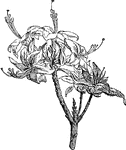
Purple Azalea
A plant with the flowers having the style and stamens much exserted and are quite variable in color.…

Ivy
The common ivy is a wellknown native of Britian and most parts of Europe and some parts of America.…
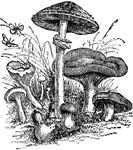
Mushroom
"The name of several classes of fungi. The best known is the common mushroom. It has a fleshy head,…

Shamrock
"The national emblem of Ireland, is a plant with a leaf formed from three leaflets. It is thought to…

Pyramid
"If a pyramid be cut by a plane, parallel to the base, so as to form two parts, the lower part is called…

Cone
"If a cone be cut by a plane, parallel to the base, so as to form two parts, the lower part is called…

Irregular Curves
"Curves other than arcs of circles are drawn with the pencil or ruling pen by means of curved or irregular-shaped…

Protractor
"The outer edge is a semicircle, with center at 0, and is divided into 360 parts. Each division is one-half…

Ovule
A section of an ovule. An ovule is a structure found in seed plants that develops into a seed after…

Fig Plant
The fruit of Ficus carica, which is native to Asia. The genus is an enormous one in the tropics. There…

Great Black Backed Gull
"A long-winged water-bird with webbed feet, inhabiting all parts of the world. The group to which gulls…

Black-headed Gull
"A long-winged water-bird with webbed feet, inhabiting all parts of the world. The group to which gulls…
